Konrad Mazowiecki's plan seemed simple. It is enough to invite the brave Teutonic Knights to deal with the wayward pagans in Prussia. However, the prince did not foresee that the monks would soon become one of the greatest threats - not to his enemies, but to the very existence of Poland.
Middle East, the end of the 11th century. After the first crusade to the Holy Land (1096–1099), the Kingdom of Jerusalem was established, which, together with the counties of Edessa and Tripoli and the Principality of Antioch, formed a state of considerable size. Victorious Christians, however, faced a real challenge:how to defend themselves against the attacks of infidels and how to ensure the safety of pilgrims? Knightly orders came to the rescue. One by one, the Knights Hospitaller, Templars and finally the Teutonic Knights entered the arena of history.
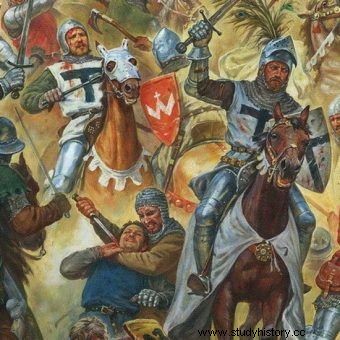
For several centuries, the Teutonic Knights posed a great threat to Poland. How did they appear in Eastern Europe?
The full name of the assembly of the latter is the Order of the Hospital of Our Lady of the German House in Jerusalem. It comes from the fact that initially, from 1128, only the German hospital brotherhood operated in Jerusalem. Only in 1190, thanks to Prince Frederick of Swabia, it took the form of a knightly order. The official attire of the brothers was a white cloak with a black cross.
In the oath, the Teutonic Knights promised poverty, but the institution they created did not in the least prevent it from becoming rich . Brave monks became the favorites of the powerful of the world who did not spare their penny. As a result, at the beginning of the thirteenth century, the congregation had land in Germany, the Czech Republic, Italy, Austria, Lorraine and Alsace. However, already at this stage it was evident that new times were coming. As Professor Henryk Samsonowicz explains in the book “Władcy Polski. A story re-told ”:
In the 13th century, the idea of crusades to the Holy Land was slowly running out, which the authorities of the most important knightly assemblies were aware of. Forced out of the Middle East, the religious had to find a new formula and place for their core activity:defending the faith and exterminating dissenters.
Hungarian monks adventure
King Andrzej II of Hungary extended a helping hand to the Teutonic Knights. In 1211, he settled monks in Transylvania (near today's Brasov in Romania). He entrusted them with the task of repelling attacks by the pagan Cumans, a Turkish tribe that had wandered in the Black Sea steppes. The order was granted a number of privileges:it could build castles and cities from wood, hold markets and participate in the income from mines and mint. In the following years, the ruler also allowed them to build Kreuzburg Castle outside their estate.
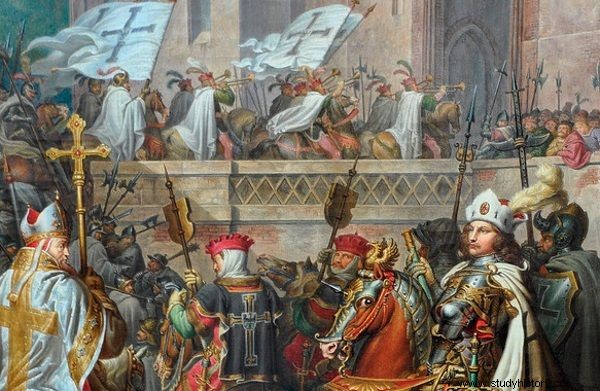
When the idea of crusades was exhausted, the knightly orders had to find a new occupation. But how did the Teutonic Knights end up in Malbork?
The brothers did not waste a chance given by fate. They fought the enemy effectively and very quickly settled and organized life in the areas assigned to them. They were not going to be satisfied with what they received from the monarch. This one gave them a finger - they wanted to take the whole hand.
Without the consent of Andrzej II, they began to expand the area they controlled. They tried to exclude him from royal jurisdiction and submit him to the Pope. This was too much for the ruler. In 1225, he entered the lands of the Teutonic Knights with his army, ravaged them, seized their castles, and banished the monks themselves from the kingdom. Pope Honorius III's protests were to no avail.
The first attempt to create a monastic state in Eastern Europe was devastated. But soon Konrad I of Mazovia came out with an interesting proposition for the Teutonic Knights.
Pagan Prussia
It was customary for Prussia to define the Baltic areas between the Vistula and the Neman. The peoples who lived there were also called "Prusians". Pomezanie, Pogezanie, Warmiacy, Skalowie, Yotvingians, Samogitians and Lithuanians - although these groups were quite diverse, at some point they began to consolidate and cooperate. It also made them more and more dangerous to their neighbors.
It is estimated that no more than 170,000 people lived in Prussia in the 13th century. The vast majority of the area was covered with forests. The main activities of the tribes were farming, breeding and, of course, plundering. Pagan warriors developed a very clever tactic of warfare. If the opponent's forces were outweighed, they fled to the forest. And when the invader returned with the prey after ravaging an area, an unpleasant surprise awaited him:an ambush.
The decisive battle took place in the forests and swamps. And even when the Prusai lost it, not much changed. Of course, they paid tribute and even got baptized. But as soon as the enemy left their territory, they denied any obligations. In this situation conquering their lands was an almost impossible task - this could only be done by standing troops, ready to fight at any moment. And these are the ones they found:the Teutonic Knights.
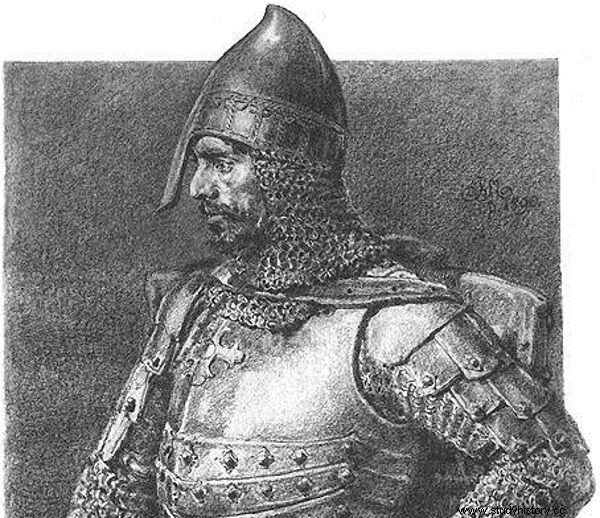
The threat from the Prusai was real - no wonder Konrad decided to seek help.
It is worth adding that pagan tribes posed a real threat to Poland. The Prusai did not avoid invasions on the lands of Christian rulers. As he tells in the book “Władcy Polski. A story told anew ”professor Henryk Samsonowicz:
They robbed castles, churches and houses, and burned towns on the border [with Mazovia - ed.] that began to emerge there at the beginning of the 13th century. A good example is Błonie nad Utrata then called Nrowa. A dozen or so strongholds were built on the line of this river to protect Mazovia. The Balts ravaged them constantly, and the principality's border began to move dangerously south .
Konrad's request
How did Konrad come up with the idea of inviting the Teutonic Knights to Poland? He was probably acting at the instigation of Henry the Bearded, who had wider contacts in the West than he did. Having made his decision, at the end of 1225 or at the beginning of 1226, he asked for help from the Grand Master of the Teutonic Knights, Hermann von Salza. As an endowment, he promised the order to grant the Chełmno land on the border of Prussia.
The brothers keep the iron hot while it is hot. As early as March 1226, Emperor Frederick II, the leader of the Christian world, approved Konrad's donation. At the same time, however ... he gave the order all of Prussia under direct control! Although initially this act was of little practical importance, it quickly became clear that it was the basis for creating one's own state on the conquered territories. Own, that is, independent of Prince Konrad and his successors, and associated only with the Reich.
After completing the formalities, the Teutonic Knights had no choice but to come to their new territories. Legend has it that it happened as early as 1226. Apparently, two monks with servants came to Konrad's court then. They lived on oak branches, around which they later built the first stronghold on the Vistula River. It was called Vogelsang (Bird Singing) and it was said to be near Toruń.
But, like many legends, this one has little to do with reality. The first knights of the Order came to the lower Vistula only in 1228 . In 1229 and 1230, they obtained further privileges from Conrad, then approved by the bull of Pope Gregory IX.
Battle after battle
The Order set out with vigor to take control of the Chełmno Land, which was partly under the control of the Prussians. Thanks to a good and modern organization, he was gaining more fortresses. Already in 1232, he took control of Chełmno, and two years later he built a castle in Radzyn, the former seat of the governor of Krystian. This spectacular success ended the first stage of conquest.
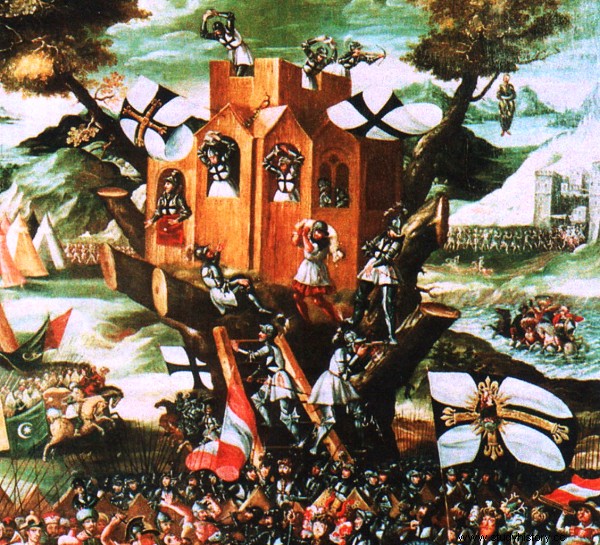
The Teutonic Knights built fortresses on the conquered lands to strengthen their power. The illustration shows the defense of Baumburg (1231).
In the fight in Prussia, the Teutonic Knights used the tactics from the times of the Crusades. After defeating their opponent, they built a castle, manned it and returned home. Pagans tried to recapture the city, but usually to no avail. Especially since the besieged could count on the help of a new expedition which usually smashed the enemy to dust and continued to march deep into enemy territory .
After taking control of the Vistula area, the brothers targeted the lands along the border with Mazovia, and then along the Baltic Sea. And so in 1237 they reached the coast. In 1255, with the conquest of Sambia, it was completely taken over. The inland areas were also not forgotten. And when the order united with the knights of the sword in 1237-1242, it additionally received sovereignty over Livonia.
Uprisings in Prussia
The Teutonic Knights ruled by terror in the captured territories. They treated the conquered peoples as slaves, and the conversion of pagans to Christianity with the sword was an everyday reality. No wonder there were revolts.
The first uprising against the new hosts broke out during the conquest of Pomezania in 1242. The gauntlet was thrown to the order by the Duke of Gdańsk Pomerania, Świętopełk II. He wanted to break his nascent power. He was supported by the Prusai. Despite initial successes, including cutting off the Teutonic castles from Western supplies, succumbed to the overwhelming force of the enemy . In 1248, a decisive battle took place near Dzierzgoń, from which the knights emerged with a shield. Peace was signed a year later. Interestingly, during the seven years of fighting, Prince Konrad himself and his sons stood on their side.
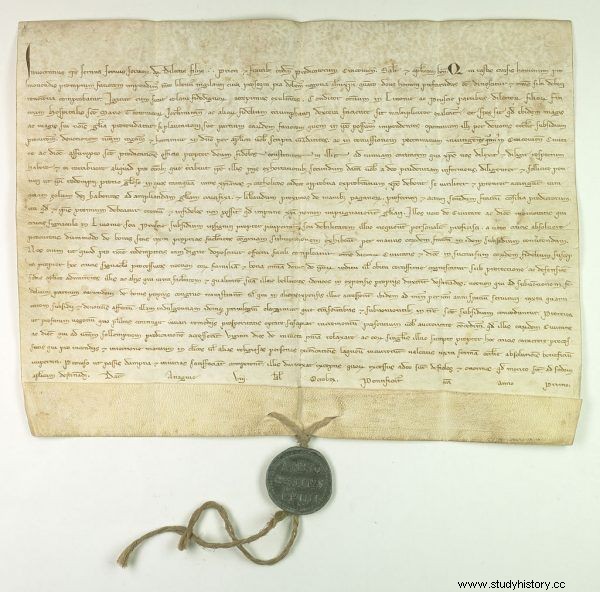
To help the Teutonic Knights fighting against the Prussian insurgents, Pope Innocent IV announced a crusade to Prussia.
The second uprising broke out in 1260 after the defeat of the monks in the battle with the Samogitians over Durba. All tribes living between the Neman and the Vistula participated in the armed uprising. During the first five years of fighting, pagan warriors fought many victorious battles. Time, however, played in favor of the monks.
The common Prussian uprising was not able to capture and maintain the fortified strongholds that were the base for the Teutonic troops. Pope Clement IV, who announced a new crusade to Prussia . Help was also coming from many western principalities. The resistance of the Prusians gradually weakened, and finally in 1274 - after 14 years of fighting - it finally collapsed.
At that time, Konrad Mazowiecki had been dead for many years. When he died in 1247, his "guests" already controlled the entire fringes of the later monastic state. There were still independent Prussian tribes inside. In 1283, i.e. about half a century after their arrival in Poland, the Teutonic Knights had all of Prussia at their fingertips.
